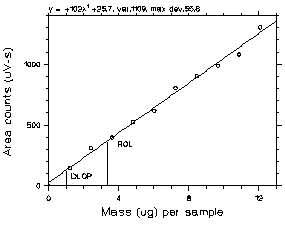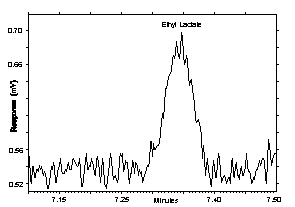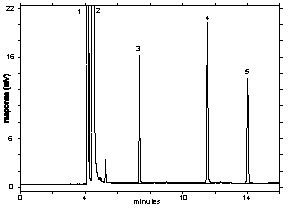1. General Discussion
1.1 Background
1.1.1 History
This evaluation
was undertaken to establish a suitable sampling and analysis procedure
for ethyl lactate. A study for n-butyl lactate collected with charcoal
tubes showed an average recovery of 100% from the desorption study.
This report describes a similar analytical method for sampling and
analysis of ethyl lactate.
1.1.2 Toxic effects (This section is
for information only and should not be taken as the basis of OSHA
policy.) (Ref. 5.1 and 5.2)
Ethyl lactate is a central nervous
system depressant and lethal to animals in high concentration (actual
levels not stated) causing respiratory paralysis. (Ref. 5.1) Ethyl
lactate is irritating in a rabbit eye and guinea pig skin. Ethyl
lactate is moderately toxic. The probable oral lethal dose (human)
0.5-5 g/kg, is between 1 ounce and 1 pint or 1 pound for a 70 kg
person (150 lb). (Ref. 5.2)
1.1.3 Workplace exposure (Ref.
5.3)
Ethyl lactate is used as solvent for nitrocellulose,
cellulose acetate, many cellulose ethers, resins; lacquers, paints,
enamels, varnishes, stencil sheets, safety glass and flavoring. No
data is available on the extent of workplace exposure.
1.1.4
Physical properties and other descriptive information (Ref. 5.3 unless
otherwise indicated)
| Synonyms: |
Actylol, acytol, ethyl
a-hydroxypropionate, ethyl
2-hydroxypropionate (Ref.5.4) |
| CAS number: |
97-64-3 |
| IMIS: |
E227 |
| RTECS: |
OD5075000; 8612 (Ref. 5.4) |
| DOT: |
UN1192 (Ref. 5.4) |
Vapor pressure:
|
0.67 kPa (5 mg Hg @ 30ºC) (Ref.
5.5) |
| Molecular weight: |
118.13 |
| Flash point: |
46.1ºC (115ºF)(CC) |
| Boiling point: |
154ºC |
| Melting point: |
-25ºC (Ref. 5.5) |
| Odor: |
Mild odor |
| Color: |
Colorless, liquid |
| Density: |
1.0324 @ 20.4ºC/4ºC |
| Molecular formula: |
C5H10O3
|
| Structural formula: |
 |
The analyte air concentrations throughout this method are based on
the recommended sampling and analytical parameters. Air
concentrations listed in ppm are referenced to 25ºC and 101.3 kPa
(760 mmHg).
|
1.2 Limit defining parameters
1.2.1 Detection limit of the overall
procedure (DLOP)
The detection limit of the overall procedure
is 1.0 µg per sample (0.021 ppm or 0.10 mg/m³). This is the amount of
analyte spiked on the sampler that will give a response that is
significantly different from the background response of a sampler
blank.
The DLOP is defined as the concentration of analyte that
gives a response (YDLOP) that is significantly different
(three standard deviations (SDBR) from the background
response (YBR).
The direct measurement of YBR and
SDBR in chromatographic methods is typically inconvenient,
and difficult because YBR is usually extremely low.
Estimates of these parameters can be made with data obtained from the
analysis of a series of samples whose responses are in the vicinity of
the background response. The regression curve obtained for a plot of
instrument response versus concentration of analyte will usually be
linear. Assuming SDBR and the precision of data about the
curve are similar, the standard error of estimate (SEE) for the
regression curve can be substituted for SDBR in the above
equation. The following calculations derive a formula for the
DLOP:
 |
Yobs = observed response
Yest = estimated response
from regression curve
n = total no. of data points
k = 2 for
a linear regression curve |
At point YDLOP on the regression
curve
| YDLOP = A
(DLOP ) +
YBR |
A = analytical sensitivity (slope)
|
therefore
Substituting 3(SEE) + YBR for
YDLOP gives
The DLOP is measured as mass per sample and expressed as
equivalent air concentrations, based on the recommended sampling
parameters. Ten samplers were spiked with equal descending increments
of analyte, such that the highest sampler loading was 12.07 µg/sample.
This is the amount, when spiked on a sampler, that would produce a
peak approximately 10 times the background response for the sample
blank. These spiked samplers, and the sample blank, were analyzed with
the recommended analytical parameters, and the data obtained used to
calculate the required parameters (A and SEE) for the calculation of
the DLOP. Values of 100.89 and 33.56 were obtained for A and SEE
respectively. The DLOP was calculated to be 1.0 µg/sample (0.021 ppm
or 0.10 mg/m³).
Table 1.2.1
Detection Limit of the Overall Procedure
|
mass per sample
(µg) |
area counts
(µV-s) |
|
0
1.21
2.41
3.62
4.83
6.03
7.24
8.45
9.66
10.86
12.07 |
0
145
310
397
526
618
803
903
987
1081
1304 |
| |

Figure
1.2.1 Plot of data to determine the
DLOP/RQL |
1.2.2 Reliable quantitation
limit (RQL)
The reliable quantitation limit is 3.33 µg per
sample (0.07 ppm or 0.33 mg/m³). This is the amount of analyte spiked
on a sampler that will give a signal that is considered the lower
limit for precise quantitative measurements.
The RQL is considered the
lower limit for precise quantitative measurements. It is
determined from the regression line data obtained for the
calculation of the DLOP (Section 1.2.1), providing at least 75%
of the analyte is recovered. The RQL is defined as the
concentration of analyte that gives a response (YRQL)
such that
Y RQL - YBR
= 10 (SDBR) |

Figure
1.2.3 Chromatogram of the RQL |
therefore
2. Sampling Procedure
2.1 Apparatus
2.1.1 Samples are collected using a
personal sampling pump calibrated, with the sampling device attached,
to within ±5% of the recommended flow rate.
2.1.2 Samples are
collected with solid sorbent sampling tubes containing coconut shell
charcoal. Each tube consists of two sections of charcoal separated by
a urethane foam plug. The front section contains 100 mg of charcoal
and the back section, 50 mg. The sections are held in place with glass
wool plugs in a glass tube 4-mm i.d. x 70-mm length. For this
evaluation, SKC Inc. charcoal tubes (catalog number 226-01, Lot 120)
were used. 2.2
Technique
2.2.1 Immediately before sampling,
break off the ends of the sampling tube. All tubes should be from the
same lot.
2.2.2 Attach the sampling tube to the pump with
flexible tubing. It is desirable to utilize sampling tube holders
which have a protective cover to shield the employee from the sharp,
jagged end of the sampling tube. Position the tube so that sampled air
passes through the front section of the tube first.
2.2.3 Air
being sampled should not pass through any hose or tubing before
entering the sampling tube.
2.2.4 Attach the sampler vertically
with the front section pointing downward, in the worker's breathing
zone, and positioned so it does not impede work performance or
safety.
2.2.5 After sampling for the appropriate time, remove
the sample and seal the tube with plastic end caps. Wrap each sample
end-to-end with a Form OSHA-21 seal.
2.2.6 Submit at least one
blank sample with each set of samples. Handle the blank sampler in the
same manner as the other samples except draw no air through
it.
2.2.7 Record sample volumes (in liters of air) for each
sample, along with any potential interferences.
2.2.8 Ship any
bulk samples separate from the air samples.
2.2.9 Submit the
samples to the laboratory for analysis as soon as possible after
sampling. If delay is unavoidable, store the samples in a
refrigerator. 2.3 Desorption
efficiency
The desorption efficiencies of ethyl lactate were
determined by liquid-spiking the charcoal tubes with the analytes at 0.1
to 2 times the target concentration. The loadings on the tubes were
24.1, 120.7, 214.4, and 482.8 µg of ethyl lactate. These samples were
stored overnight at ambient temperature and then desorbed and analyzed.
The average desorption efficiency over the studied range was
97.82%.
Table
2.3
Desorption Efficiency of Ethyl Lactate
|
|
%
Recovered |
|
0.1 × |
0.5 × |
1.0 × |
2.0 × |
| Tube # |
24.1 µg |
120.7 µg |
241.4 µg |
482.8 µg |
|
1
2
3
4
5
6 |
97.25
97.89
98.85
99.43
98.10
98.12 |
96.19
95.88
96.64
95.97
95.19
96.25 |
97.10
98.39
98.52
97.99
99.44
99.67 |
99.37
98.17
98.15
98.19
98.87
97.96 |
average |
98.27 |
96.02 |
98.52 |
98.45 |
overall average |
97.82 |
|
|
|
standard
deviation |
±1.20 |
|
|
|
|
2.4 Retention
efficiency
Six sampling tubes were spiked with 482.8 µg (10.0 ppm
or 48.3 mg/m³) of ethyl lactate, allowed to equilibrate for 24 hours at
room temperature, and then 10 L humid air (80% RH at 21ºC) was drawn
through each tube at 0.2 Lpm. They were opened, desorbed, and analyzed
by GC-FID. The retention efficiency averaged 95.7%. There was no ethyl
lactate found on the back sections of the tubes.
Table
2.4
Retention Efficiency of Ethyl Lactate
|
| Tube # |
% Recovered |
|
Front section |
Back section |
Total |
|
1
2
3
4
5
6 |
95.64
94.93
95.96
96.79
95.40
95.47 |
0
0
0
0
0
0 |
95.64
94.93
95.96
96.79
95.40
95.47 |
|
|
average |
95.70 |
|
2.5 Sample
storage
The front sections of twelve sampling tubes were each
spiked with 241.4 µg (5.0 ppm or 24.1 mg/m³) of ethyl lactate. They were
sealed and stored at room temperature. The next day 10 L of humid air
(80% RH at 21ºC) was drawn through each tube at 0.2 L/min. Half of the
tubes were stored in a drawer at ambient temperature and the other half
were stored in a refrigerator at 0ºC. After 7 days of storage three
samples from the tubes stored under refrigeration and three samples from
ambient storage were analyzed. The remaining samples were analyzed after
15 days of storage. The amounts recovered, which are not corrected for
desorption efficiency, indicate that the samples should be refrigerated.
The samples stored in a refrigerator had an average recovery of
90.0%.
Table
2.5
Storage Test for Ethyl Lactate
|
Ambient Storage
|
|
Refrigerator
Storage
|
| Time (days) |
% Recovered |
|
Time (days) |
% Recovered |
|
|
|
7
7
7
15
15
15
average
|
64.1
60.1
60.3
50.0
50.7
55.6
56.8
|
|
7
7
7
15
15
15
average
|
91.8
93.0
92.3
86.2
88.9
88.0
90.0
|
|
|
|
|
|
|
|
2.6 Recommended air
volume and sampling rate.
Based on the data collected in this
evaluation, 10 L air samples should be collected at a sampling rate of
0.2 L/min.
2.7 Interferences (sampling)
2.7.1 It is not known if any compounds
will severely interfere with the collection of ethyl lactate on the
sampling tubes. In general, the presence of other contaminant vapors
in the air will reduce the capacity of the charcoal tube to collect
ethyl lactate.
2.7.2 Suspected interferences should be reported
to the laboratory with submitted samples. 2.8 Safety precautions (sampling)
2.8.1 Attach the sampling equipment to
the worker in such a manner that it will not interfere with work
performance or safety.
2.8.2 Follow all safety practices that
apply to the work area being sampled.
2.8.3 Wear eye protection
when breaking the ends of the glass sampling tubes.
3. Analytical
Procedure
3.1 Apparatus
3.1.1 The instrument used in this
study was a gas chromatograph equipped with a flame ionization
detector, specifically a Hewlett Packard model 5890.
3.1.2 A GC
column capable of separating the analyte from any interferences. The
column used in this study was a 60-m x 0.32-mm i.d. Rtx-volatiles, 1.5
µm film thickness.
3.1.3 An electronic integrator or some
suitable method of measuring peak areas.
3.1.4 Two milliliter
vials with Teflon-lined caps.
3.1.5 A 10 µL syringe or other
convenient size for sample injection.
3.1.6 Pipets for
dispensing the desorbing solution. A 1-mL dispenser was used in this
study.
3.1.7 Volumetric flasks - 5 or 10 mL and other
convenient sizes for preparing standards. 3.2 Reagents
3.2.1 GC grade nitrogen, hydrogen, and
air.
3.2.2 Ethyl lactate, Reagent grade
3.2.3 Methylene
chloride, Reagent grade
3.2.4 Methanol, Reagent
grade
3.2.5 n-Heptanol, Reagent grade. This was used as an
internal standard.
3.2.6 Desorbing solution was 95/5 (v/v)
methylene chloride/methanol with 0.25 µL/mL n-heptanol internal
standard. 3.3 Standard
preparation
3.3.1 At least two separate stock
standards are prepared by diluting a known quantity of ethyl lactate
with the desorbing solution. The concentration of these stock
standards was 241.4 µg/mL.
3.3.2 A third standard at a higher
concentration, 965.6 µg/mL, was prepared to check the linearity of the
calibration. Dilutions of the stock standards were made with the
desorbing solution to obtain lower working range standards.
3.4 Sample preparation
3.4.1 Sample tubes are opened and the
front and back section of each tube are placed in separate 2-mL
vials.
3.4.2 Each section is desorbed with 1-mL of the
desorbing solution.
3.4.3 The vials are sealed immediately and
allowed to desorb for 60 minutes with intermittent shaking.
3.5 Analysis
3.5.1 Gas chromatograph
conditions.
| Injection size: 1
µL |
|
Flow rates
(mL/min)
|
|
| Nitrogen
(make-up): |
30 |
| Hydrogen(carrier): |
3 |
| Hydrogen(detector): |
30 |
| Air: |
400 |
Temperatures
(ºC)
|
|
| Injector: |
200 |
|
| Detector: |
225 |
|
| Column: |
50-170 at 10
ºC/min | |

Figure 3.5.1 A chromatogram of
the target concentration, where the peaks are
identified as follows: 1=methanol, 2 = methylene chloride,
3 = ethyl lactate, 4 = n-heptanol, and 5 = butyl
lactate. |
3.5.2 Peak
areas are measured by an integrator or other suitable means.
3.6 Interferences
(analytical)
3.6.1 Any compound that produces a
response and has a similar retention time as the analyte is a
potential interference. If any potential interferences were reported,
they should be considered before samples are desorbed. Generally,
chromatographic conditions can be altered to separate an interference
from the analyte.
3.6.2 When necessary, the identity or purity
of an analyte peak may be confirmed by a GC-mass spectrometer or by
another analytical procedure. 3.7 Calculations
3.7.1 The instrument was calibrated
with a standard of 241.4 µg/mL ethyl lactate in the desorbing
solution. The linearity of the calibration was checked with a standard
of 965.6 µg/mL (20 ppm).
3.7.2 If the calibration is
non-linear, two or more standard at different concentrations must be
analyzed, bracketing the samples, so a calibration curve can be
plotted and sample values obtained.
3.7.3 Values (µg) obtained
from the blanks are subtracted from air samples.
3.7.4 To
calculate the concentration of analyte in the air sample the following
formulas are used:
| mass of analyte
in sample = |
(mg/mL)(desorption volume)
desorption efficiency |
| number of moles of analyte
= |
mass of analyte in sample
molecular weight |
Volume the analyte will occupy at 25ºC and 760 mmHg is
number of moles of analyte times the molar volume at 25ºC and 760
mmHg.
| ppm = |
(volume analyte
occupies)(106)
air volume |
3.7.5 The
above equations can be consolidated to the following
formula.
| ppm = |
(mg/mL)(DV(24.46)(106)(g)(mg)
(10 L)(DE)(MW)(1000 mg)(1000 mg) |
µg/mL = concentration of analyte in sample or
standard
24.46 = molar volume (liters/mole) at 25ºC and 760
mmHg
MW = molecular weight (g/mole)
DV = desorption volume
10
L = 10 liter air sample
DE = desorption efficiency
* All
units must cancel.
3.7.6 This calculation is done for each
section of the sampling tube and the results added together.
3.8 Safety precautions
(analytical)
3.8.1 Avoid skin contact and
inhalation of all chemicals.
3.8.2 Wear safety glasses, gloves
and a lab coat at all times while in the laboratory areas.
4. Recommendations for
Further Study
Collection studies need to be performed.
5.
References
5.1 Browning, E., "Toxicity and
Metabolism of Industrial Solvents", American Elsevier, New York,
1965.
5.2 Gosselin, R.E., H.C. Hodge, R.P. Smith, and M.N.
Gleason, "Clinical Toxicology of Commercial Products", Fourth Edition,
Williams and Wilkins, Baltimore, 1976.
5.3 Lewis, R., "Hawley's
Condensed Chemical Dictionary", Twelfth Edition, Van Nostrand Reinhold
Co., New York, 1993, p. 495.
5.4 Sweet, D., "Registry of Toxic
Effects of Chemical Substances", 1985-86 Edition, U.S. Department of
Health and Human Services, Public Health Service, Center for Disease
Control, NIOSH, 1987, Vol. 3A, p. 3024.
5.5 Clayton, G.D. and
F.E. Clayton, "Patty's Industrial Hygiene and Toxicology", Third
Edition, John Wiley Sons, New York, 1981, Vol. 2A, pp.
2304-5.
|

